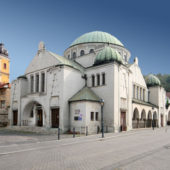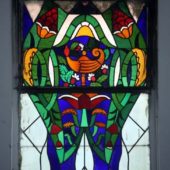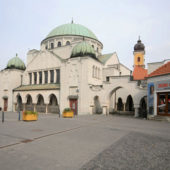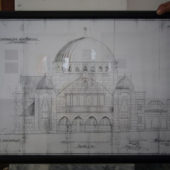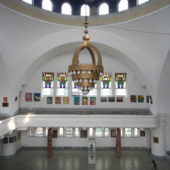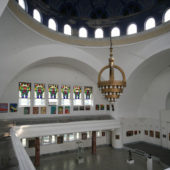Byzantine in design, reminiscent of the Istanbul’s Hagia Sofia Mosque, this synagogue is now used for art exhibitions, lectures and performances.
The Synagogue of Trencin is an imposing building of Byzantine design, prominently sited near the center of the city. The Jewish population of Trencin and the building have undergone a tumultuous history. Although small, there continues to be a remnant of Jewish community in this city.
As early as the 14th century there is record of several Jews in Trencin, although details of their history is unknown. After the Kuruc invasion of Ubersky Brod in 1683, some Jews fled to Trencin. Over the following century, the Jewish community was under the jurisdiction of Ubersky Brod. In 1734 they took a secret oath not to use the Hungarian justice system to settle any disputes, only Ubersky Brod’s court. In the early 1700s, Jews from Moravia also immigrated to Trencin. They initially lived outside the town walls, but over time, were eventually incorporated inside the city limits. The Trencin Jewish community grew from 81 in 1727, to 989 in 1869, in 1922 the population reached its peak of 2115 members, and in 1940 to 1619. However, after the Holocaust, the community’s numbers were decimated to only 326. Early on, the community held minyan (religious services made up of at least 10 men) in private homes, and in 1736 they built a Jewish school. The community hired its first rabbi, David Kahn Casid, in 1736; however, the town charged the Jews heavy taxes for weddings and circumcisions, which were prohibited. Jews were not allowed to employ Christian servants. In 1703 Jews opened a company that produced a scarce oil, used in tanning hides. In the beginning of the 18th century, Jews traded in hides and bones, and produced spirits. In 1834 the congregation acquired a synagogue and in the beginning of the 19th century the school was enlarged. In 1857 a government-run Jewish elementary school was founded; it had such a good reputation that many gentile children also attended. After the Congress of Hungarian Jewry in 1878, the community joined the Reform (Neolog) Jewry. At the end of World War I Jewish homes and property were ransacked and people were murdered. The community rebuilt their lives yet World War II brought more destruction and death, including desecration of the Synagogue and theft of all its religious articles.
Trencin Synagogue’s construction began in 1911 and was completed in 1913. It was designed by Berlin architect Richard Schneibner and was often described as one of the most beautiful in Hungary (the area became Czechoslovakia at the end of World War I and in 1993, Slovakia). It is an unusual combination of Byzantine and Art Nouveau design, with its simple exterior decoration and monumental concrete dome construction. The prayer-room is a large sanctuary, which old photographs reveal as being once colorfully decorated. Today, the only original fragments of decoration that remain are the blue dome, some stained glass windows and the chandelier. The prayer-room is now painted white, and the domed ceiling is vividly painted in blues with tan and white accents. A large art-deco chandelier drops down from the center of the dome, with rings of white round bulbs. Soaring ceiling arches taper down into the four corners of the room. Further large arched insets are worked into the walls. Arched windows flank the sides of the room, and are placed inside arched insets, with bright paintings adorning them. The stained glass windows are situated upstairs. Unusual, square red marble block pillars along the sides and back of the sanctuary provide support for the upper balcony (the women’s gallery), which is molded and shaped with curves and is also painted white.
The congregation also had a cemetery and a kosher butcher. There were many social, religious, women’s and charitable groups within the community. After the Synagogue was desecrated in WWII, it was reconstructed from 1974 to 1984 and today, the space under the dome serves the larger community as a cultural center for art exhibitions, lectures and performances. In 1990 a small worship room at the back of the complex was restored.
Today, there are approximately twelve people in the Jewish community. They meet in a small prayer-room in the back of the Synagogue complex. They also maintain the cemetery on Partizánska Street. There is a Holocaust memorial plaque on the wall in this small prayer-room, listing the victims from Trencîn. The few remaining Jews still meet and keep Jewish faith, traditions and culture alive in the small restored prayer-room, continuing the traditions of the Trencîn Synagogue.

